Art Journaling with Colored Pencils
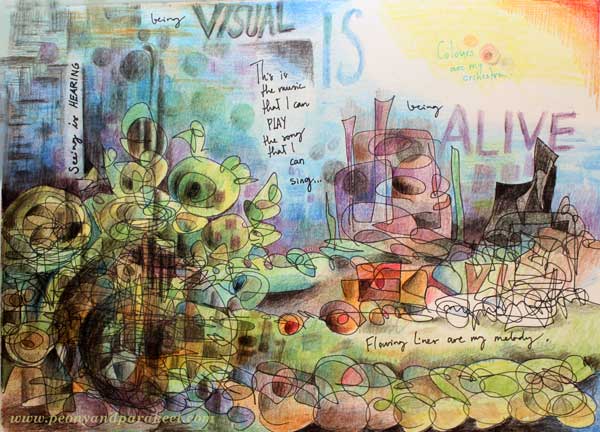
My latest art journal page started with new colored pencils and rambling thoughts of the latest news from Helsinki: the architecture competition of Guggenheim Museum has ended and now there’s a big debate whether the city of Helsinki should finance the museum or not. I did not mean to include the winner building on the page, but you know how it goes: once you think something, it will appear! See the black element on the right!
Cretacolor Aqua Monolith Watercolor Pencils
Last Monday I went to the biggest art supply store in Helsinki to buy some paper and see if they had any Cretacolor Aqua Monolith Watercolor Pencils. I had bought one pencil about a year ago just to see how it works. After many months, I noticed the growing use of that pencil. So now I was thinking to buy a couple more. It turned out that they did not sell the pencils individually anymore, so I bought the smallest set of 12.
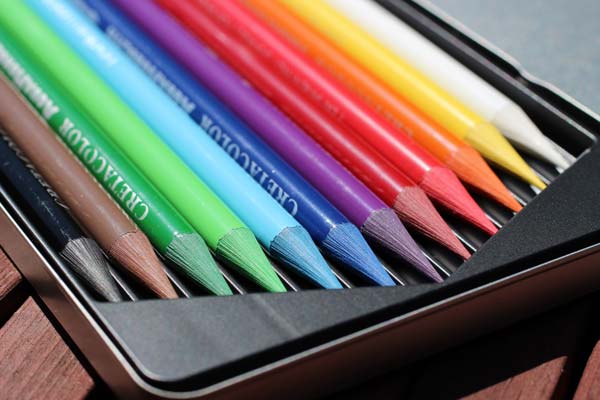
As you can see from the picture, these pencils are nothing like ordinary colored pencils! They are not wooden at all; they only have a thin lacquer coating! For me, it took some time to get used to how they feel when holding them. But once I got over it and started treating them as any pencil, (pressing lightly and creating multiple thin layers), I noticed that they work great. These pencils are soft enough to make the coloring pleasurable but not too soft for detailed work.
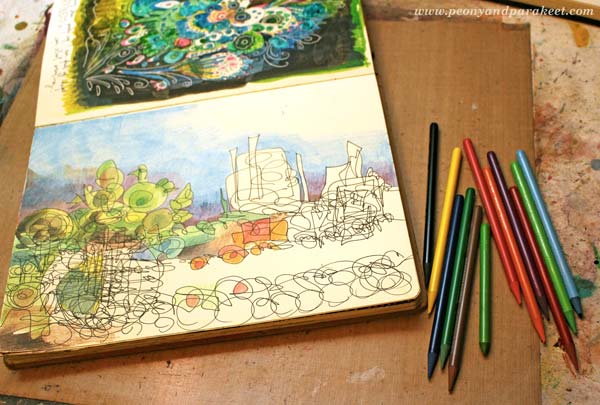
It is fascinating that you can also use shavings if you add a little bit water to them!

My art journal page was made without water – these watercolor pencils work well that way too.
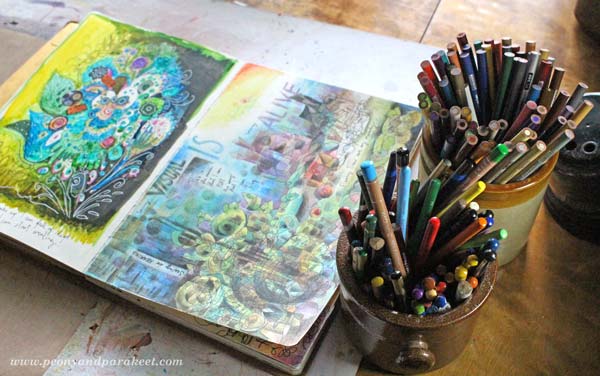
All of my colored pencils fit in two jars as I usually use them all at the same time, no matter what their brand or type is.
Adding Journaling to the Page
I was drawn to green tones even if I was thinking of the city view. There’s something magical when the tourists arrive Helsinki in the spring. They make shy and withdrawn Finnish people more friendly and helpful. When the hard winter is over, everybody is willing to make a fresh start.
While continuing the coloring of the page, I thought about cultural institutes and their events. Whether it is a city full of tourists or a concert hall full of audience, it feels alive and uplifting. It gives me energy and inspiration to create once I get back home. I felt drawn to the word “alive” and decided to add some words to the page too. By erasing some areas after coloring, I created areas for writing.
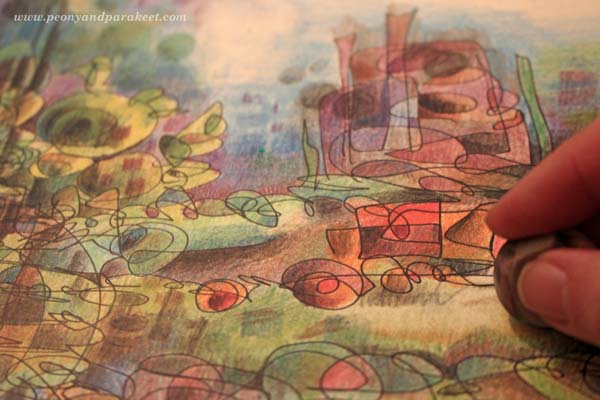
For me, being alive is a visual thing. When I am using my senses, I see images. When I draw the images, I feel alive.
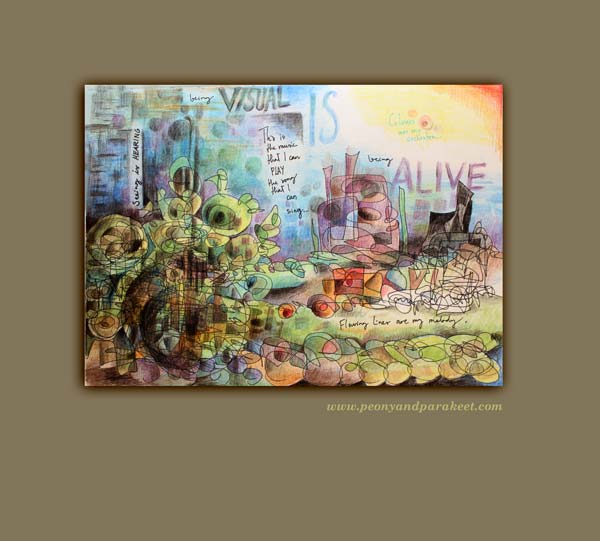
Create an art journal page with colored pencils and words by answering:
What does make you feel alive?
Subscribe to my weekly emails and get a free mini-course!
Using Fabric on Art Journal Pages
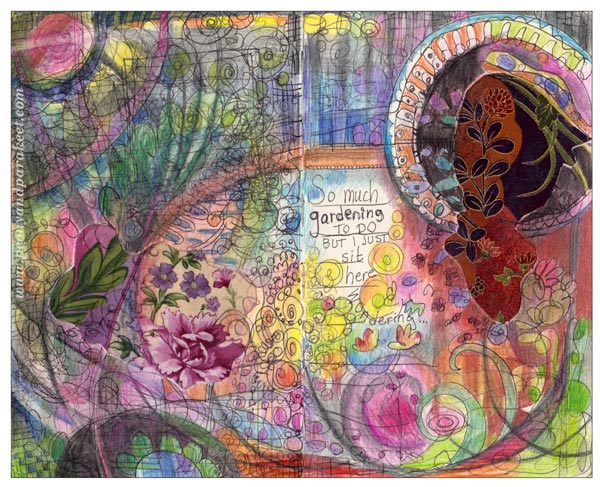
At this time of the year, at the beginning of summer, there’s a lot to do in the garden. I started early this year, but recently there has been so many activities that I feel I have neglected the garden. This guilty feeling also showed up on my latest art journal page!
This page is made on a spread of Moleskine Sketchbook, so the image is fairly small, about 10 inches in width. A special feature here is that I have added two small cotton fabric pieces to boost my imagination. Using the technique of fabric collage was just a sudden idea, but I love how the page feels when touched!
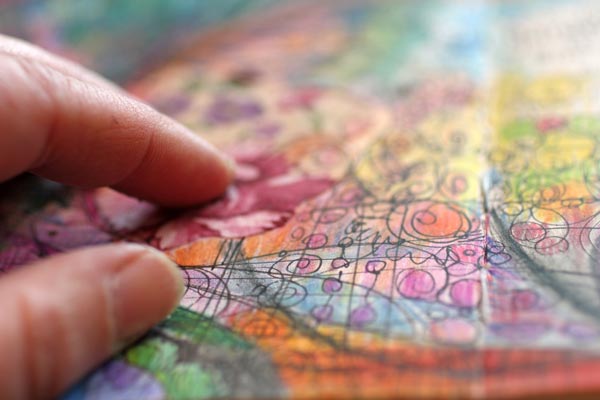
I attached the first fabric piece at the early stage. Golden Soft Gel Gloss Medium was used for attaching the fabric.
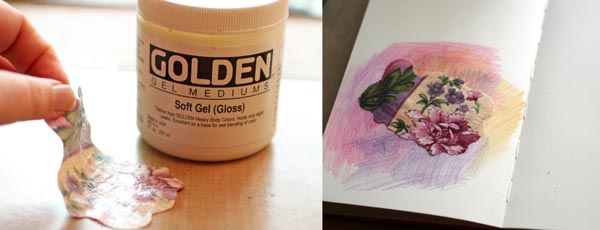
After attaching the fabric, I doodled with a black drawing pen to get the creativity going.
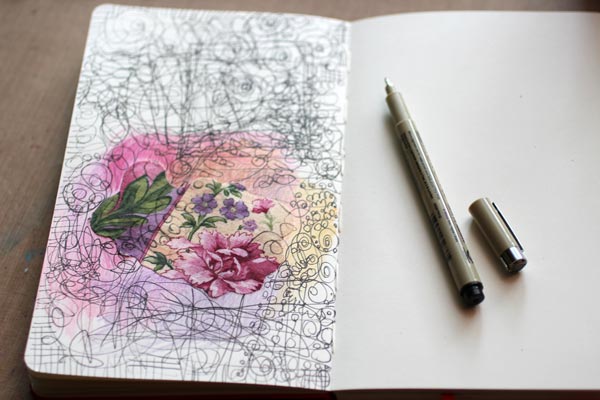
When I began coloring, I realized that I want to create a spread instead of a page. So I attached another fabric, purposefully a bit different from the first.
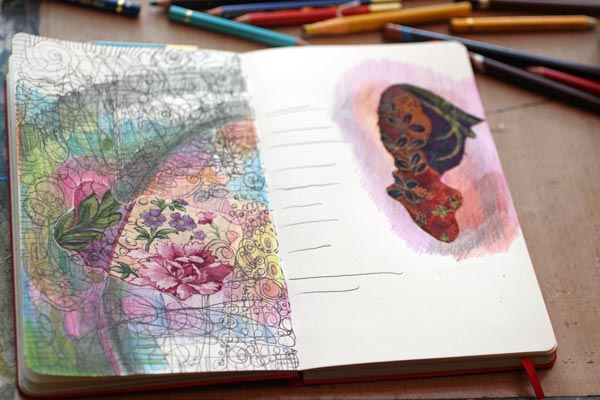
While coloring the page, I added more details. As my garden looks wild at the moment, I wanted to show the growth on the page too.
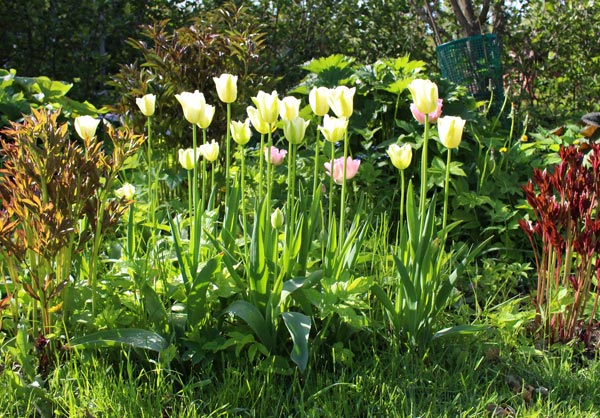
Here’s one corner of our front garden. Tulips bloom beautifully, and peonies (my favorites, of course!) grow fast. Lots of weeding to be done!
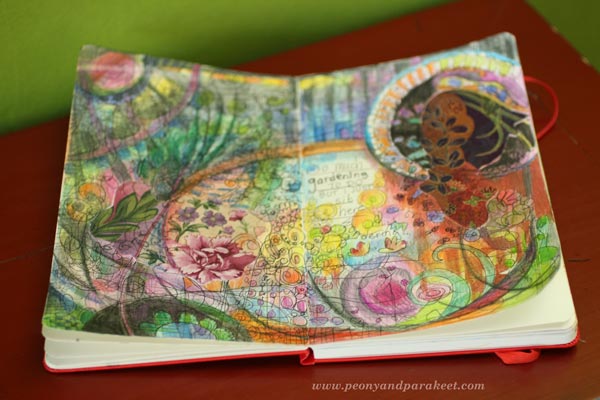
Why not try some fabric collage in your journal?
Let me be your art teacher: Subscribe to my weekly emails!
Intuitive Start for Art Journaling
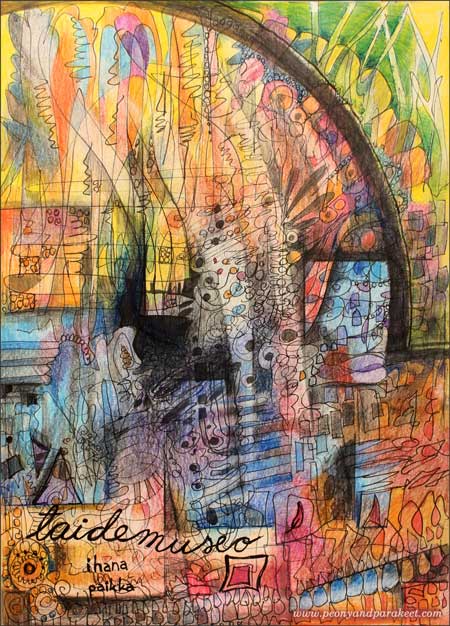
My latest art journal page is about one of my favorite places: art museums. On the page, I have used both organic and graphic shapes to express the interaction between art and architecture. That interaction is something I enjoy examining when handling art museum inspiration.
Inspiration
Last week I went to Kunsthalle Helsinki to see an exhibition of Erling Neby Collection. Erling Neby is a Norwegian businessman who collects concrete and geometric art.
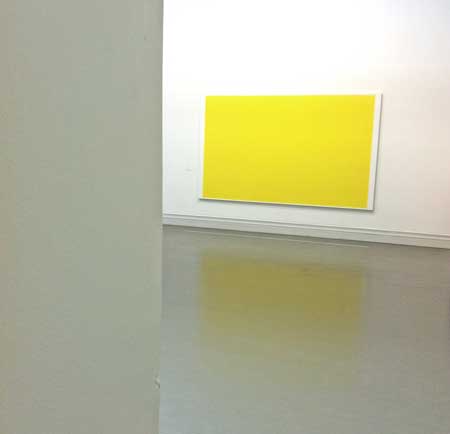
This kind of art makes me remember the time when I was in my 20s and very certain of what kind of art I like and what I don’t like. Simple-shaped abstract paintings were in my comfort zone back then – it was “good art” that I was excited to see and experience although I have never been able to stretch my personal style to that.
At the exhibition, the reflection of the yellow painting was especially inspiring. It made me think how art is never disconnected from its surroundings, whether physical or mental. Thus, an illustration about art museum would not need to separate artworks from the architecture but express the holistic feeling of the experience.
Techniques
I used a couple of black pens and colored pencils for creating the page.
1) Free doodling and coloring.
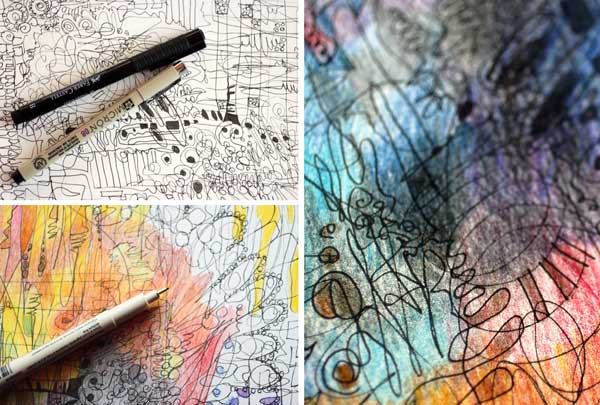
2) Drawing sharp graphic shapes with the help of a ruler and a round object. 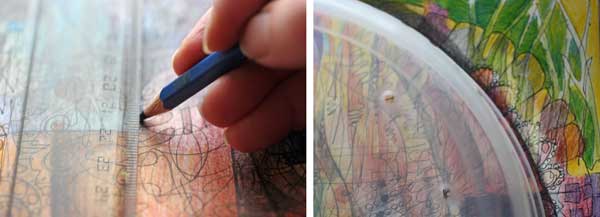
Emotional Connection
When I draw, I always want to get an emotional connection with the subject. Without that, I start to worry about the result before the first stroke! When making this page, I did not think about art museums in general. Instead, I thought about tiny details that I saw and tiny moments that I remembered from my last visit in Kunsthalle Helsinki. I focused on the feeling and let my imagination work with that.
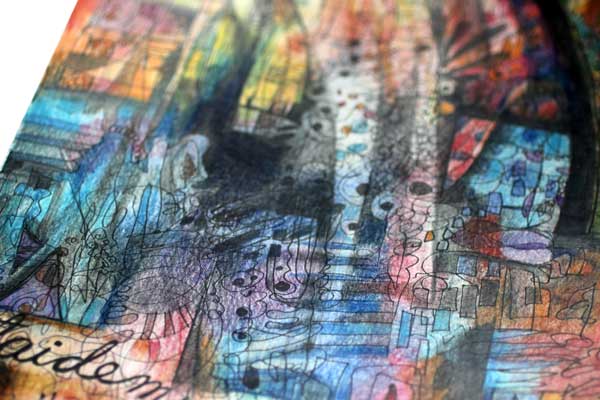
Inspirational Drawing
Working from tiny details towards the big picture is something that is not easy to explain in a single blog post. To explain it shortly, it is starting with an intuition and then slowly bringing the page towards the intention. This way of working is in the main role in Inspirational Drawing.
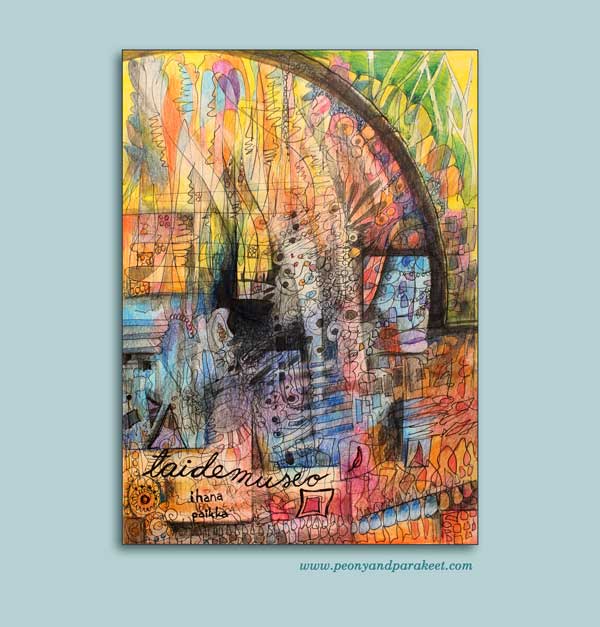
Inspirational Drawing is built so that you can enjoy developing the three dimensions of drawing:
1) increasing your imagination
2) improving your technical skills
3) using inspirational source material.
You will learn a creative process in detail through art journaling exercises. Course videos will not only show you how to do, but I also talk about the emotions and the inspiration behind them. I will answer your questions and help you adjust the process so that it will work for you. You can start enjoying free drawing without questioning what to draw or how the process itself will take care of that!
Why History, Computers and Art Belong Together
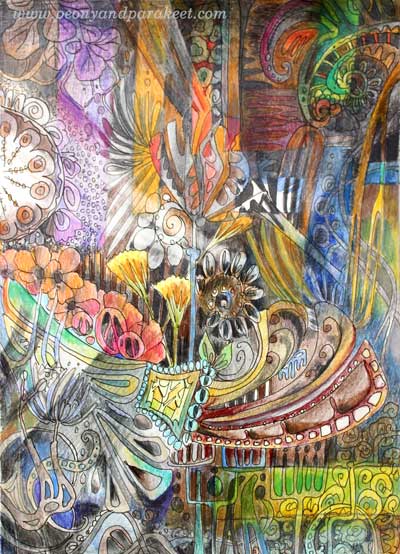
This art journal page is about two things that are close to me: art nouveau and computer engineering. With my background in technology, many find it surprising that historical styles like Art Nouveau fascinate me so much. And vice versa: why someone so interested in history, has studied and worked with computers.
Inspiring Periods of World History
For me, history, computers, and art have a natural connection. Think about the era of Art Nouveau: the end of 19th century and the beginning of 20th century. It was the era of the industrial revolution when many technical inventions were born. Also, at the same time, new kind of art was emerging. For example, Virginia Woolf wrote books using the stream of consciousness, Vincent van Gogh painted Starry Night, and Charles Rennie Macintosh designed a grand building for Glasgow School of Art. After inventing computers, we are experiencing another great era with a lot of innovations, the internet, and smartphones among others. I am certain that it will be seen as one of the most exciting time in the world history. We have new tools for art and design and we if any can use art to look at what the future could hold.
The Stream of Consciousness – Creating a Coloring Page
When I started to create the art journal page, I thought about the two eras and their similarities. With a black drawing pen, I began drawing art nouveau style shapes. It was exciting to think about modern things while drawing in the old style. It is very inspirational to stay focused on two things that have both similarities and differences.

It is relaxing to draw like imitating Virginia Woolf: using the stream of consciousness. Rotating the page makes it easier to keep the stream flowing.
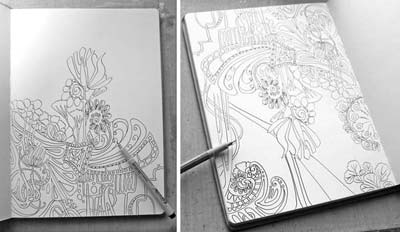
Coloring books seem to be popular at the moment. We art journalers can make our own! Here’s my page before coloring.
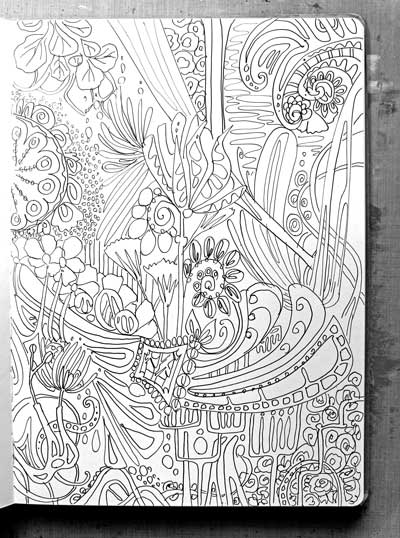
Past, Present, Future – Art Is an Equation
When I studied computer engineering, I had to understand a mathematical equation that was used widely to control technical systems. It was called Kalman filter and it was composed of three parts: past, present and future. I found the philosophy behind the equation most fascinating: to get better at what we do, we must understand the past, stay grounded to the present and be brave enough to predict the future.
Art can be our equation. We can use art to ponder on what has happened to us. We can use art to record the present. But most importantly: art can make us get off the ground. We can predict what the future will hold by taking old and current stuff and create new combinations. We can imagine what Virginia Woolf would do in the 22nd century and illustrate it. There are no limits and we already have most of the information.
That’s why I think that history, computers and art belong together. They are all parts of the same equation.
Adding New Dimensions by Coloring
To bring today’s graphic shapes to the work, I drew rectangular areas on the top of the drawing. Then I colored them with a different color scheme.

Finally, I expressed how past can bring us the future by erasing color with a light strokes. The light comes from the past. With the past, we can see the future.
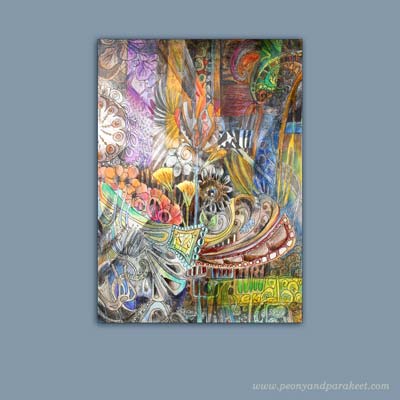
Tell me, what have you picked (or would like to pick) from the past to your art?
Create your own colored version of this page!
>> Buy Coloring Freely!